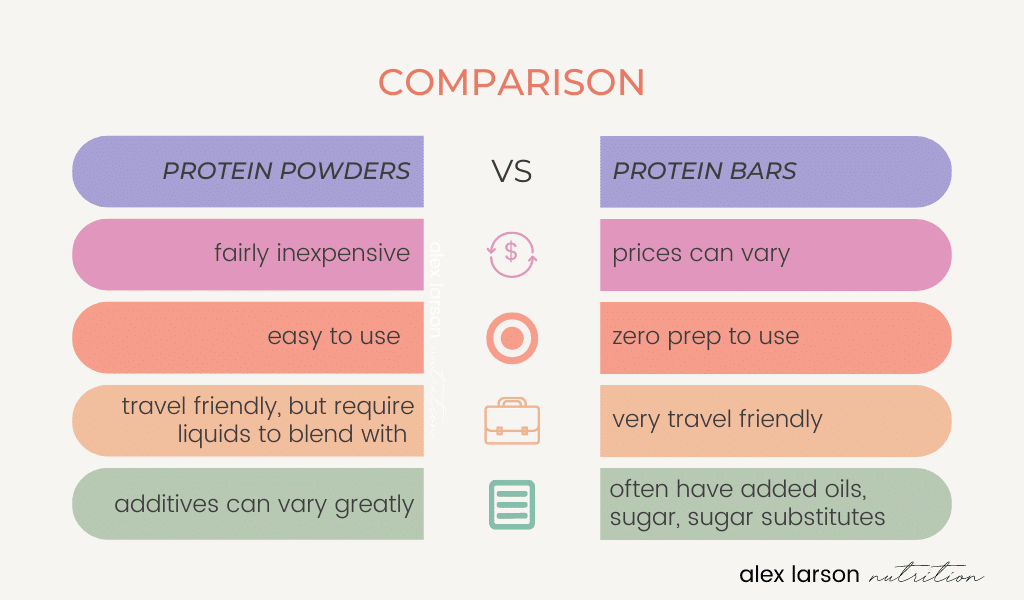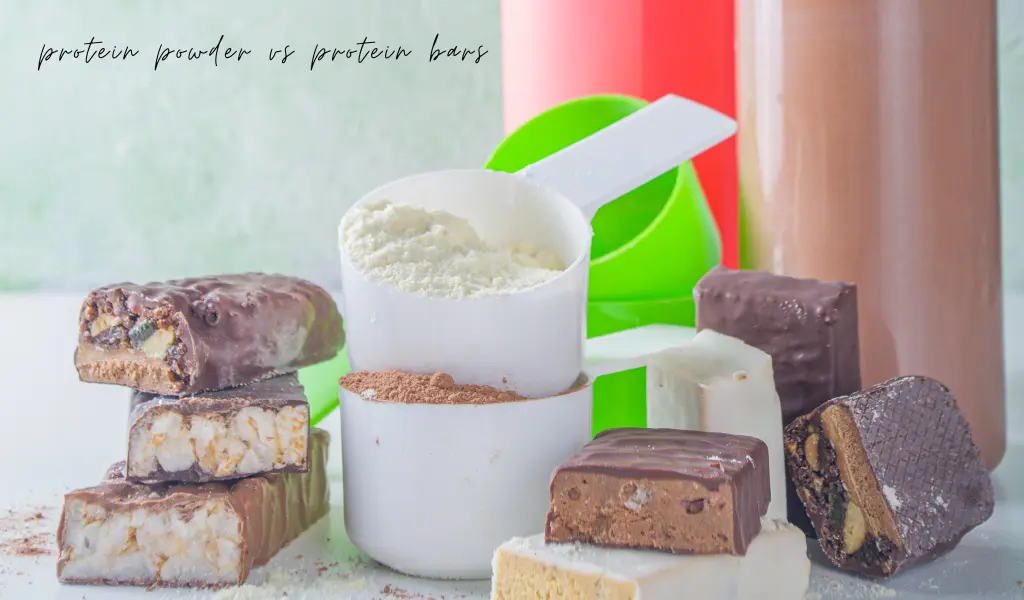Level Up Your Nutrition Game With Our Freebies
Alex
I provide nutrition coaching for endurance athletes to improve performance and body composition through a simple and flexible eating style.
Hi, I'm
ATHLETE EATING GUIDE →
LEARN MORE →
ATHLETE GROCERY SHOPPING GUIDE →
10-DAY PROTEIN-PACKED SAMPLE MEAL PLAN
READY TO FUEL?
incredible value!
The fueling guide bundle serves as your one-stop-shop for strategies to fueling before, during and after your workouts.
When it comes to protein powders and protein bars, the endless options can feel overwhelming. Using products such as these can make meeting your protein goals a lot easier, and tasty too! Let’s compare protein powder vs protein bars.
Endurance athletes and runners have increased calorie and protein needs. Our dietitian team frequently sees athletes struggle to consistently get in enough protein. Protein-rich foods such as Greek yogurt, cottage cheese, eggs, lean meats can be difficult to leave the house with when you’ve got a busy, on-the-go lifestyle.
With the versatility of the protein products available online and at the grocery store, it’s tricky to know what to look for and avoid. This review will help you determine which products may be best to supplement with.
Benefits of protein powder vs protein bars for runners
While one is not necessarily better than the other, both protein powders and protein bars have different beneficial characteristics depending on what you’re needing.
Protein powders are fairly inexpensive per serving, convenient, and relatively easy to use for on-the-go travel and workouts. Most protein powders are stored in medium-sized containers which allow for easy scooping and mixing the powder with a liquid such as milk or plant-based milk alternative.
Research shows that consuming protein, including protein powders, and carbohydrates post workout can optimize muscle recovery and glycogen replenishment. Incorporating powders and bars into your routine can make it easier to meet your off-season and in-season nutrition goals.
Protein bars have similar positive attributes as protein powders with the low price point, ease of use, and convenience. Protein bars are easy to store in your gym bag or purse and holding your appetite over until the next meal. Fortunately, both protein powders and bars will make it through airport safety checkpoints and are a great option to pack if you are traveling.

The inside scoop: comparing ingredients
There are grocery store aisles often have entire aisles dedicated to protein powders and bars which can make overwhelming to know what is best. The prettiest or most expensive package is not always the best option. Furthermore, the ingredients in both protein powders and protein bars vary across a huge spectrum.
One of the most common types of protein powders available is whey. It’s dairy-based protein and it’s considered one of the high-quality protein due to it containing all nine essential amino acids, and an excellent source of the amino acid leucine. Leucine is well researched and plays the role of signaling the body to start building muscle.
Whey protein and other complete protein sources such as chicken, eggs, dairy and soy reign supreme as your body is able to digest and utilize the protein very well. However, there are many plant-based protein powder options also available including soy, pea, hemp, flaxseed, among others.
Many protein powder options include added ingredients. Commonly seen include:
- unsweetened cocoa powder,
- salt,
- a low-calorie sweetener such as stevia, sucralose, or sugar alcohols for flavor.
- Fortification of vitamins and minerals
Protein powders are often flavored to make the product more desirable, though there are unflavored options as well.
Often, protein bars will include protein powder to boost the protein content of the bar. Many bars available contain whey protein, egg white protein, or soy protein. It’s common to find ingredients such as added oils, sugar or sugar substitutes for this reason.

Protein powder vs Protein bars: When to use
Both protein powders and bars can be an excellent addition to a meal or as a post-workout snack. Blend protein powders well with fresh or frozen fruit, milk and almond butter for a refreshing addition to your morning bowl of oatmeal.
If you’re utilizing the protein powder or bar post-workout, ideally refuel within 60 minutes of workout. Because most protein shakes are low in carbohydrates, try adding a banana or a bowl of cereal with It. Reference our protein blog post for more protein-related specifics.
Protein bars are a great go-to to incorporate into your routine if you’re needing a quick boost of energy. With persistent life demands, you may not necessarily have the time or energy to prepare a more elaborate snack and that’s okay! Pair your protein bar with a serving of fruit or veggies to satisfy your appetite.
Which has better nutritional content?
Protein powders will generally contain mostly protein isolate, meaning very low fat and carbohydrates. Most whey protein powders contain approximately 100-150 calories and 20-25g of protein per serving. Typically you get more bang for your buck by consuming protein powder. As a protein bar, at most, only contain 10-15g per serving.
When choosing a protein powder and/or bar, consider choosing a bar that’s higher in protein and lower in added sugars. Many protein bars available can also be very high in calories and fat so be mindful of your specific nutrition needs.
Preventing hunger
Any food that is consumed in the solid versus liquid form is going to likely be more satisfying because it takes longer for your body to digest. Therefore, most of our athlete clients find that protein bars paired with fruit, veggies, or a handful of dry cereal is more satisfying than a protein shake. However, consider adding high-fiber ingredients to your protein smoothie. Such as, oats, ground flaxseed or chia seeds, fresh or frozen fruit. This can make your protein shake equally as satisfying.
Too much of a good thing
While I’ve shared about both protein powders and protein bars. If you find yourself substituting meals and snacks with these products, it may be best to focus on decreasing how often you’re using them. Substituting protein powders and bars for whole foods can make it difficult to get in enough vitamins, minerals, and other important nutrients to keep you well-fueled and healthy. The term ‘supplement’ typically implies in addition to. Therefore, consider adding the protein powder and/or protein bar in addition to your nutritious and balanced meals versus replacing your meals with these products.
What ingredients should you avoid?
Many protein shakes and bars may contain unnecessary ingredients such as sugar alcohols and artificial sweeteners which may result in unwanted gastrointestinal side effects such as gas and bloating. Tread lightly with these products, particularly if you are in the middle of your training cycle or heading into race day.
As the performance nutrition post discusses, it is also important to purchase a protein powder that is third-party tested such as Informed Choice for Sport or NSF-certified. Unfortunately, there are many low-quality products available that have tested positive for various substances including heavy metals and contaminants, and having that third-party testing can provide you with peace of mind.

A few protein powder favorites to try for yourself:
- Thorne (whey and plant-based options) I love Thorne’s whey protein isolate powder and this link will get you 15% off)
- Klean
- Momentous protein (whey and plant-based options)
- BiPro
- Vega Sport (plant-based)
A few protein bar favorites:
- Rx
- Rx plant-based
- Kind
- ALOHA
- GoMacro
Which are better? Protein powder vs protein bars?
Cliffhanger! I’ll let you choose and let us know what you like best!
Truly, this depends on the individual as each person has unique taste and texture preferences and specific nutrition goals. Both protein powders and protein bars have positive attributes and can be a healthy part of your nutrition program. Though ideally these products are used in addition to your nutrition plan versus as a meal replacement.
If you are still having a hard time deciding what works best for you after reading his post, reach out and my dietitian team and I can help you decide!
Alex
I provide nutrition coaching for endurance athletes to improve performance and body composition through a simple and flexible eating style.
Hi, I'm
LEARN MORE →
take the quiz!
Let's discover your Endurance Nutrition IQ
How well do you know your fueling? Answer these questions and let's see where your endurance nutrition knowledge is at!
Take the quiz
level up your nutrition game with these freebies
free downloadS
Protein-Packed 10-Day Sample Meal Plan
Athlete Eating Guide
Athlete Grocery Shopping Guide
1
2
3
Inspiration to fit 120 grams of protein into your day
Planning what goes on your plate
Putting the right foods in your grocery cart